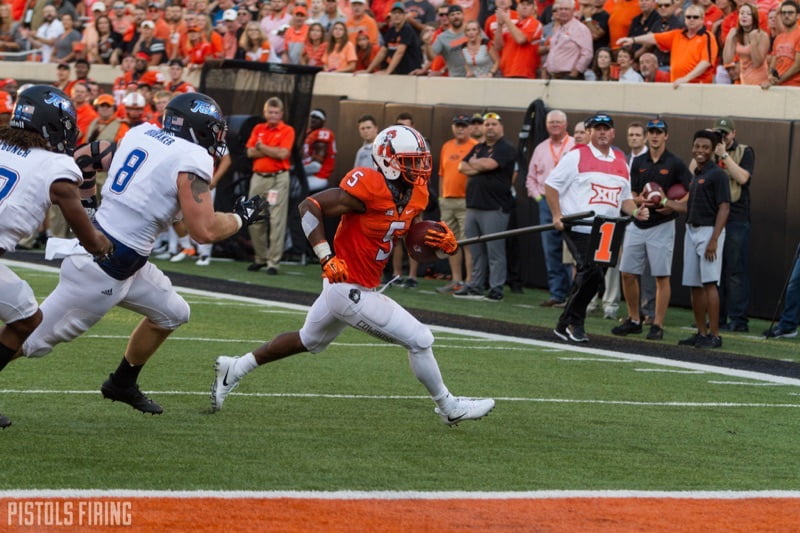Football
Oklahoma State Run Game: Why It Will Be Feast or Famine at Times

After a dominating performance last Friday, it’s tough to find areas for criticism. But I feel like the run game was certainly lacking the punch it did in the opener vs. Tulsa. I mentioned in a previous article that Justice Hill didn’t have his best game, and in general the OL was lacking physicality to open up large rushing lanes against an inferior opponent.
But also there are other components to the equation that lead to lack of success. In my film study, I found two plays that I wanted to highlight to bring some clarity as to why. Let’s focus on two main areas.
- Fast pace — how that can impact run game negatively.
- Zone blocking scheme and some of the downsides that occur at times.
Play No. 1
I’ll set the stage for you here. It’s 1st and 10, and J.D. King just had a nice 7-yard run. OSU is looking at a 2nd and 3 inside the red zone. On 2nd and 3, Mike Yurcich wants to play with pace to try and catch a tired defense off guard. It’s a pretty simple strategy. This play is set up so fast that the camera crew almost doesn’t have enough time to switch it back to the normal game watching frame. It’s a pretty basic run play with zone blocking concepts and is designed to go off the left side.
The only problem is this play doesn’t favor OSU. Whether it was planned this way or not, South Alabama has a strategic advantage on this play, even with the pace going as fast as it did.
Oklahoma State is in their base package, 11 personnel, with one Cowboy Back offset right behind the RT. Both corners are showing press coverage with one high safety. This means that there are seven guys in the box against six available blockers. That is a disadvantage that you want to avoid. The problem is, given the fact that OSU is trying to play fast, sometimes you don’t have time to evaluate those factors as much as you would in normal play.
For the most part this play is blocked as it should be. Aaron Cochran is responsible for the man in front of him (SDE), Marcus Keyes is responsible for the man in front of him (DT), and ideally you would like Brad Lundblade to make it to the second level to seal off the LB. He doesn’t quite make it there due to traffic, and that’s possibly a reason why King cut the run back up to the middle/right.
Larry Williams at RG is responsible for blocking the man in front of him (DT), and Zach Crabtree is responsible for getting the second level and sealing off the backside LB. Britton Abbott needs to make sure backside DE isn’t able to crash down LOS and make a play. All of this happens reasonably well, with exception of Lundblade’s block. The problem is that the weak-side LB goes unblocked and makes a play at the line of scrimmage. A lot of times the run game is strictly numbers vs. numbers, and in this case OSU lost the numbers game.
Normally this would probably be a check play, but given the pace it’s something that you just roll with. It’s another reason why OSU was able to have so much success in the RPO game on slants, with the LBs really crashing in hard against the run, leaving them exposed in the middle of the field in pass game.
Before you start complaining about the pace, remember plays like this don’t happen without it. The example above of an unsuccessful play is just cost of doing business.
Play No. 2
The next play is the downside of zone blocking. The idea of zone blocking is to block the man in front of you. If there is no one in front of you then it’s your responsibility to move play side and help other lineman with defenders in their zone. This can also change based of play design, where the entire line shifts and you’re responsible for players in front of you in that particular area post-shift.
A pretty big key to zone blocking is to have mobile offensive lineman, ones that can get out of their stance and move laterally to a certain spot. You’ll see exactly what I mean from this play.
In this play I really only want people to focus on the RG Larry Williams and the RT Zach Crabtree. Due to the alignment of the DL, this play is challenging for these guys. Since the play is going left, the entire line is moving left as well. Lundblade is responsible for getting a block on the LB at second level, which leaves the DT in 0 technique right in front of Lundblade for Larry Williams.
This means that after the snap Williams has to immediately slide over to try and get a block on someone who is aligned 2-3 yards to his left on the play side. Same situation as Crabtree with a DE aligned in 3 technique, although his block isn’t as difficult from a distance perspective, he is going against a more athletic player (at least I would hope so) which makes it equally as challenging.
Williams actually does a pretty nice job of getting out of his stance quickly and engaging with the DT, but ultimately the DT is still able to make the play in addition to the backside DE that Crabtree was responsible for.
To be a clear I’m a big advocate of zone blocking, I think there are a lot of reasons why it’s is a great scheme. But there are downsides to it as well, this was just trying to shine some light on that aspect. Overall these are two good examples of where the players didn’t necessarily do anything wrong, but the situation/scheme ultimately was reasoning for the play failing. Not every play is going to work all the time, but it’s good to understand why something didn’t work instead of just lighting the whole thing on fire.

-

 Wrestling4 days ago
Wrestling4 days agoThe Top 5 Quotes from John Smith’s Retirement News Conference
-

 Football5 days ago
Football5 days agoWide Receiver Prospect Kameron Powell Commits to Oklahoma State
-

 Hoops5 days ago
Hoops5 days agoReport: Former Arkansas Guard Davonte Davis to Visit Oklahoma State
-

 Wrestling3 days ago
Wrestling3 days agoOSU Wrestling: The Impact John Smith Had on His Final Boss, Chad Weiberg






